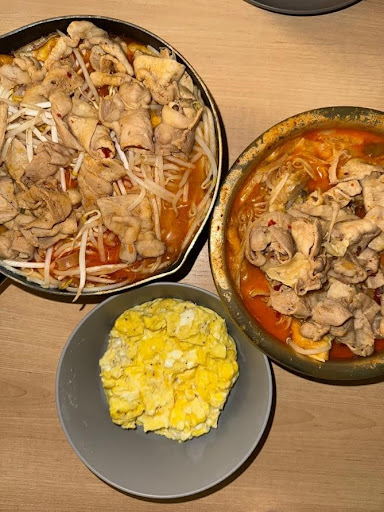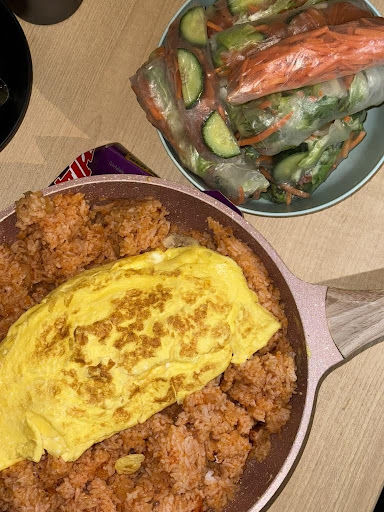Today, I want to share some of the Asian dishes I’ve been making while living in the U.S. It’s hard to believe that it’s already been almost three months since I arrived here. Although I’m enjoying my time in San Francisco, there are still moments when I really miss home. I miss the familiar streets, the language, and especially the food.
Since my time here is limited, I want to make the most of every day and turn homesickness into something positive. Whenever I start to feel lonely or nostalgic, I’ve realized that the best way to comfort myself is through food, especially the dishes that remind me of home.
When I lived in Japan, I could easily find Korean food at affordable prices in nearby restaurants. However, eating out in the U.S. can be quite expensive, so I’ve started cooking more often at home. Fortunately, there’s an Asian supermarket called H Mart near my school. It has almost everything I need, including gochujang, tofu, instant noodles, and fresh vegetables.
Every weekend, my friends and I visit the market together to explore new ingredients and cook our favorite dishes. It has become one of my favorite weekend routines and a fun way to stay connected to my culture. Today, I’d like to introduce a few of my favorite meals that I’ve made so far.

The first dish I’d like to introduce is Mala Tang, a popular Chinese hot and spicy soup. Although it originally comes from China, it became a huge trend in Korea a few years ago and is now one of the most popular comfort foods there. You can enjoy a full meal for less than $7, and the spicy flavor perfectly matches the Korean palate. It’s also great because you can enjoy a variety of ingredients such as meat, vegetables, and tofu all in one bowl.
There’s actually a restaurant in Stonestown that serves Mala Tang, but it can be quite expensive. If you add all the ingredients you want, the total can easily go over $20. So, my friends and I usually buy our favorite ingredients from H Mart and make it ourselves at home.
We like to include pork, bean sprouts, enoki mushrooms, tofu skin, and fried tofu, which together create a rich combination of flavors and textures. It’s surprisingly easy to make — once you prepare the ingredients, you just put everything in a pot and let it cook. The result is a warm, spicy, and comforting meal that always reminds me of home.

The second and third dishes I’d like to introduce are Omurice and Vietnamese Spring Rolls.
Omurice is very easy to make. You just chop vegetables like onions and carrots into small pieces, stir-fry them with rice, and then add ketchup. At SFSU, there is a Food Pantry that provides free vegetables every week, so I often use those ingredients when cooking.
The most difficult part of making Omurice is cooking the egg perfectly, but thanks to my Japanese friends, I was able to do it successfully. While making this dish, I also learned that in the U.S., eggs should always be fully cooked. In Japan, people often eat raw eggs, such as when making bibimbap, so I realized how important it is to be mindful of cultural differences in food habits.
As for the Vietnamese Spring Rolls, they were a great way to eat a variety of fresh vegetables that I don’t usually eat often. The chewy rice paper wrapped around crisp vegetables creates a refreshing combination, and dipping them in chili sauce makes them even more delicious.

The fourth dish I want to introduce is Bibim-myeon, a type of Korean instant noodles. Unlike regular ramen, this one is served cold and without soup. Instead, the noodles are mixed with a spicy and sweet sauce, which gives it a very unique flavor.
In Korea, people usually enjoy Bibim-myeon with side dishes rather than eating it alone. As you can see in the photo, it’s often paired with thinly sliced grilled pork. Wrapping the noodles with the meat creates an amazing combination of flavors that is truly satisfying.
Since my cooking skills are still improving, I often make simple dishes like this. However, I hope that one day I can make my own sauce from scratch and try more complete and creative recipes.
Living far away from home has made me think a lot about the food I used to eat in Korea. Some dishes I never thought about before now feel incredibly special to me. Cooking these meals reminds me where I come from and helps me stay connected to my culture.
Most importantly, cooking and eating together with my friends has become one of my happiest moments here. It’s not just about the food itself, but the memories we create while making it. I want to hold on to these feelings and continue cherishing them as I move forward in life.
Through these cooking experiences, I’ve realized that food is more than just something we eat every day. It has the power to connect people, comfort our hearts, and bring back precious memories. Every time I cook, I feel like I’m building a small bridge between my life in Korea and my new life in the United States. Even though I am thousands of miles away from home, one bite of familiar food can make me feel like I’m right back in my kitchen with my family.
I also discovered that cooking is a great way to share cultures with friends from different countries. Sometimes I invite my roommates to join me, and we exchange dishes from our own cultures. They love trying Korean food, and I enjoy learning how to make dishes from Japan, Vietnam, and the U.S. It’s always fun to compare flavors and cooking styles.
For future exchange students, I would strongly recommend cooking as a way to overcome homesickness. You don’t have to be a great chef—just start with something simple that reminds you of home. Cooking will not only save money but also help you build friendships and make your time abroad even more meaningful.